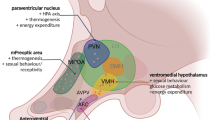Abstract
The enzyme 5alpha-reductase 1 (5α-R1) that converts testosterone (T) to dihydrotestosterone (DHT) is present in many mammalian tissues including the spinal cord. It is established that morphine administration decreases spinal cord T levels, but the mechanism is still undetermined. Here, we investigated the link between T and the enzyme 5α-R1 in the spinal cord after morphine administration. For spinal cord steroid extraction, all the animals were killed 30 min, 2 h (acute) and 14 days (chronic) after first drug injection by decapitation. The whole spinal cord was removed and kept frozen at −20°C until T and DHT extraction. The effects of acute and chronic morphine administration on 5α-R1 expression in the adult male rat spinal cord were evaluated using RT-PCR. Spinal cord T and DHT levels were measured using radioimmunoassay before and after the morphine exposure. Morphine significantly reduced the T concentration after acute and chronic exposure in the spinal cord. In contrast, the 5α-R1 expression and of course DHT levels increased the following chronic morphine administration. One important reason for the decreasing effect of morphine exposure on the spinal cord T level is due to an increase in the 5α-R1 levels. We suggest that morphine plays a regulatory role in metabolism of neurosteroids, especially T in the spinal cord via 5α-R1.


Similar content being viewed by others
References
Shoae Hassani A, Sharif S, Verdi J (2011) A 5a-reductase inhibitor, finasteride, increases differentiation and proliferation of embryonal carcinoma cell-derived-neural cells. Med Hypotheses 76:11–13
Torres JM, Sanchez P, Ortega E (2004) Quantitation of mRNA levels of steroid 5α-reductase in the rat brain by “one-step” RT-PCR and capillary electrophoresis. J Neurosci Methods 136:105–110
Pozzi P, Bendotti C, Simeoni S et al (2003) Androgen 5α-reductase type 2 is highly expressed and active in rat spinal cord motor neurones. J Neuroendocrinol 15:882–887
Poletti A, Negri-Cesi R, Rabuffetti M et al (1998) Transient expression of the 5α-reductase type 2 isozyme in the rat brain in late fetal and early postnatal life. Endocrinology 139:2171–2178
Torres JM, Ortega E (2003) Differential regulation of steroid 5α-reductase isozymes expression by androgens in the adult rat brain. FASEB J 17:1428–1433
Poletti A, Coscarella A, Negri-Cesi P et al (1998) 5α-reductase isozymes in the central nervous system. Steroids 63:246–251
Poletti A, Rabuffetti M, Martini L (1996) Effect of suramin on the biological activity of the two isoforms of the rat 5α-reductase. Steroids 61:504–505
Shoae Hassani A, Sharif S, Mortazavi Tabatabaei SA, Verdi J (2011) Could the endogenous opioid morphine, prevent neural stem cell proliferation? Med Hypotheses 76:225–229
Nestler EJ, Aghajanian GK (1997) Molecular and cellular basis of addiction. Science 278:58–63
Zimmermann M (1983) Ethical guidelines for investigations of experimental pain in conscious animals. Pain 16:109–110
Buckley CT, Caldwell KK (2003) Two-layer antibody capture of enzymes on the surface of microtiter plates: application to the study of the regulation of phospholipase C-gamma 1 catalytic activity. Anal Biochem 320:193–198
Polettio A, Celotti F, Rumio C, Rabuffetti M, Martini L (1997) Identification of type l 5α-reductase in myelin membranes of male and female rat brain. Mol Cell Endocrinol 129:181–190
Olasmaa M, Limonta P, Maggi R, Dondi D, Martini L, Piva F (1987) Further evidence that gonadal steroids do not modulate brain opiate receptors in male rats. J Endocrinol 34:521–529
Morita K, Arimochi H, Tsuruo Y (2004) Adrenergic activation of steroid 5alpha reductase gene expression in rat C6 glioma cells: involvement of cyclic AMP/protein kinase A-mediated signaling pathway. J Mol Neurosci 22(3):205–212
Morita K, Arimochi H, Her S (2005) Serotonergic 5-HT2A receptor stimulation induces steroid 5α reductase gene expression in rat C6 glioma cells via transcription factor Egr-1. Mol Brain Res 139(2):193–200
Kaneyuki T, Kohsaka M, Shohmori T (1979) Sex hormones metabolism in the brain: influence of central acting drugs on 5α reductions in rat diencephalon. Endocrinol Jpn 26(3):345–351
Mensah-Nyagan AG, Do-Rego Jl, Beaujean D et al (1999) Neurosteroids: expression of steroidogenic enzymes and regulation of steroid biosynthesis in the central nervous system. Pharmacol Rev 51:63–81
Amini H, Ahmadiani A (2005) In vivo evidence for an increase in 5 alpha reductase activity in the rat central nervous system following morphine exposure. Int J Dev Neurosci 975:1–6
Verdi J, Ahmadiani A (2007) Finasteride, a 5α-reductase inhibitor, potentiates antinociceptive effects of morphine, prevents the development of morphine tolerance and attenuates abstinence behavior in the rat. Horm Behav 51:605–610
Acknowledgments
This work is based on our present study on Opioids and Neural Stem Cells in the Laboratory of Tissue engineering and Stem cell, Research Center for Sciences and Technology in Medicine (RCSTiM) in Tehran University of Medical School, Tehran, Iran. Funding for this study is provided by the Research Center for Sciences and Technology in Medicine (RCSTM), Tehran University of Medical Sciences.
Author information
Authors and Affiliations
Corresponding author
Rights and permissions
About this article
Cite this article
Sharif, A., Shoae-Hassani, A., Sharif, S. et al. 5α-reductase 1 regulates spinal cord testosterone after morphine administration. Neurol Sci 34, 19–23 (2013). https://doi.org/10.1007/s10072-012-0936-x
Received:
Accepted:
Published:
Issue Date:
DOI: https://doi.org/10.1007/s10072-012-0936-x




